#Incunabula Short Title Catalogue
Photo

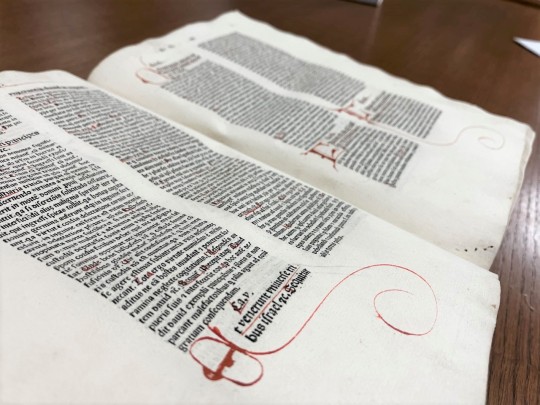
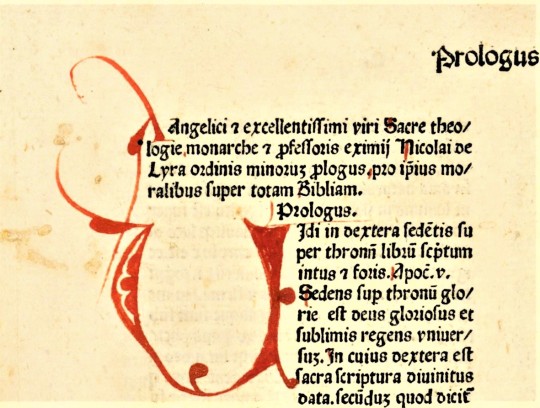


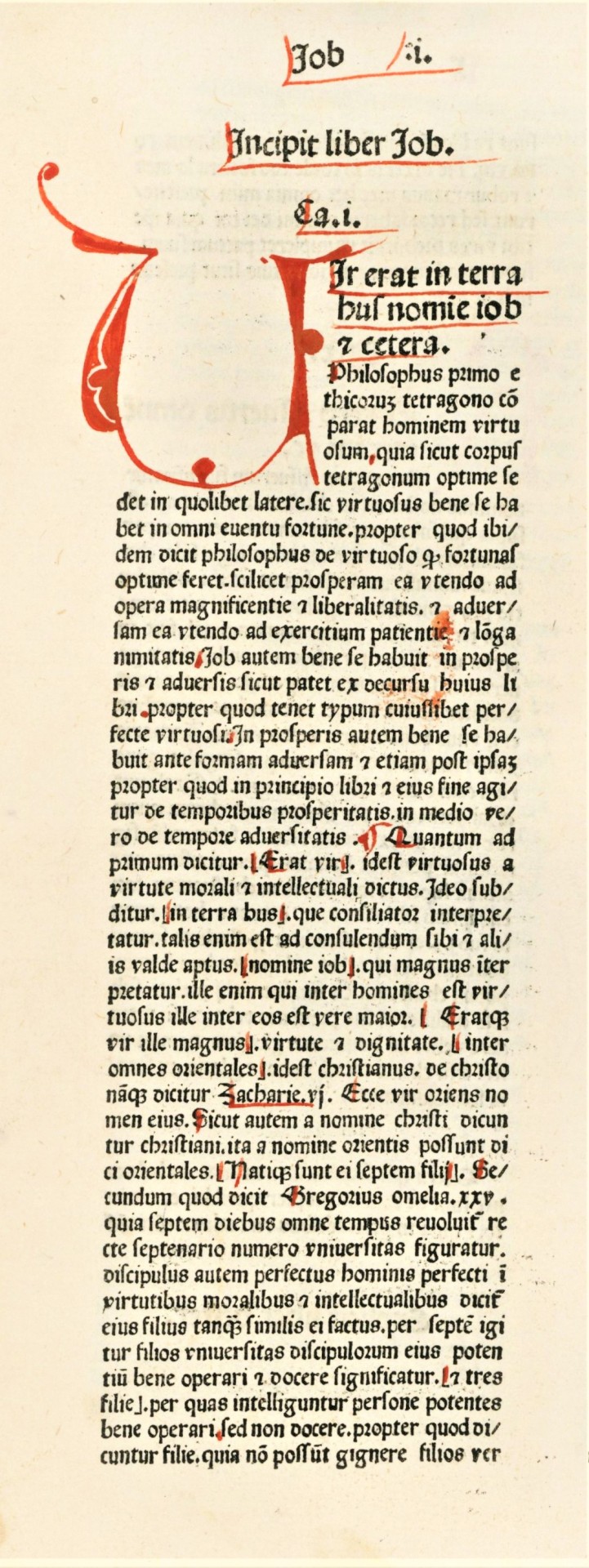
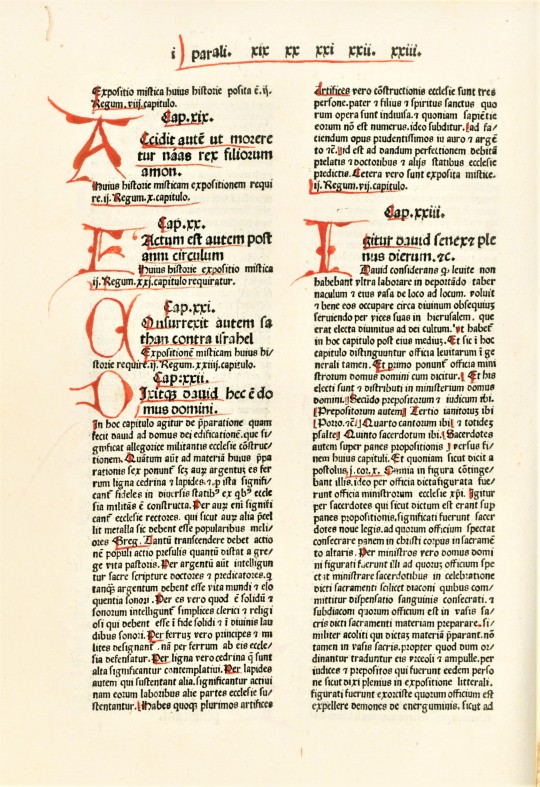


Typography Tuesday
ITALIAN ROTUNDA GOTHIC
One of the few incunables we hold that have all the initials rubricated (i.e., initials completed in red manuscript) is a 1481 printing of Nicolas De Lyra’s biblical commentary Moralia super totam Bibliam, printed in Mantua by Paulus de Butzbach. It uses a typeface modelled after a rounded Gothic manuscript hand known as Rotunda.
The Italian version of the Rotunda, that this typeface is based on, was developed for copying manuscripts at the University of Bologna in the 13th century, and is sometimes referred to as littera bononiensis. This rounded form seems to have developed to accommodate more rapid copying to provide materials for a voracious academic clientele. However, this also increased the amount of space letterforms would occupy, so a series of abbreviation conventions were developed to save space that are especially associated with the Italian Rotunda.
These can be seen throughout the examples shown here, but they are especially vivid in the colophonic text of the last image. For example, the lowercase q with a line beneath the bow signifying the word "qui," or the r rotunda (ꝛ) which follows a letter with a rounded stroke on the right side, such as the one following the o in the word ordine in the second paragraph, following the underlined name of “Nicolaus de Lyra.” You can also see the use of the visually-related Tironian et ⟨⁊⟩ used to signify etcetera. The rubricator has not only completed all the initials, but has also highlighted capital letters in red, marked paragraph openings, and underlined certain words or phrases for emphasis. The humorous artery-like illustration around the rubricated n in the second to last image was likely added much later, perhaps after William Harvey published his findings on the circulation of blood in 1628!
Not much is known about the printer Paulus de Butzbach, although he is quite well-noted as a printer for one of the first three editions of Dante’s Commedia, all three of which appeared in 1472. However, using the raw data in the Incunabula Short Title Catalogue (ISTC) we can say that he seems to have had a relatively short career from 1471/2 to 1481, when our book was printed. A German printer (as most early printers in Italy were), he appears to have begun his career with another German printer Georgius de Augusta at Verona in 1471 or 72. After printing a handful of classical titles in Verona, they moved operations to Mantua in 1472 where the Commedia was printed. They continued to work together and for others there until 1475, when Butzbach’s name begins to appear in colophons by itself, and he continues to print alone until about 1481. In those ten years, Butzbach participated in the printing of some 30 editions. Our copy of Moralia super totam Bibliam is one of only 95 worldwide noted in ISTC.
View other posts on 15th-century types.
View more Typography Tuesday posts.
#Typography Tuesday#typetuesday#Typography Tuesday#Italian Rotunda#Gothic type#littera bononiensis#rubrication#rubricated initials#Paulus de Butzbach#Nicolas De Lyra#Moralia super totam Bibliam#abbreviations#Incunabula Short Title Catalogue#ISTC#15th century type
64 notes
·
View notes
Text
The reason for publishing a short catalogue is to facilitate easier and cheaper shipping so that I can ship anyone who asks for one will get one quickly.
If you usually get my catalogues one will be on the way, If you would like one please e-mail or text me. I hope you enjoy it.
James
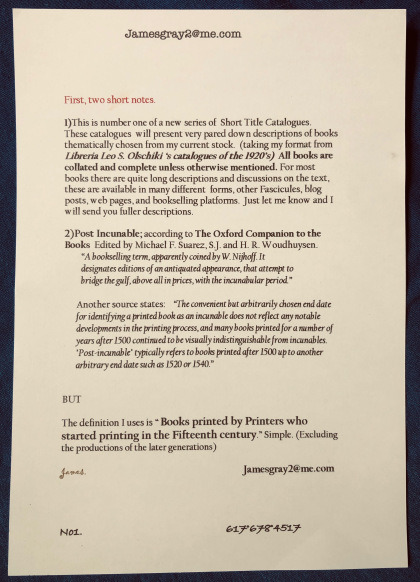

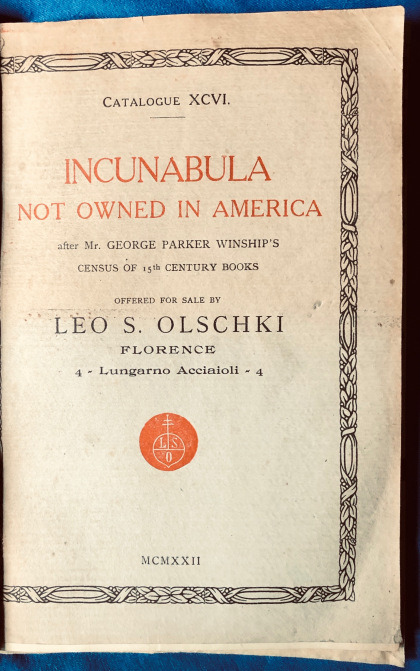
1) 269J Thomas Aquinas 1225-1274
Summa theologiae: Pars prima. Ed: Franciscus de Neritono, Petrus Cantianus, and Joannes Franciscus.
Venice: [Nicolaus Jenson] 1477. $ 18,000
Folio. Full contemporary calf over wooden boards, rubricated through- out. This is the second edition of the ‘pars prima”, the first was 1473. The Summa was written 1265–1274 and also known as the Summa Theologica or simply the Summa) is the best-known work of Thomas Aquinas.
Goff T198; HC 1442*; Mich 118; Pell 1038; CIBN T-170; Zehnacker 2241; Castan(Besançon) 95; Polain(B) 4759; IGI 9573; IBP 5300; Sajó-Soltész 3263; IDL 4392; IBE 5623; IJL2 354; SI 3796; Coll(U) 1431; Madsen 4397; Voull(Trier) 1820; Voull(B) 3669; Ohly-Sack 2743; Sack(Freiburg) 3444; Borm 2610; Bod-inc T-167; Sheppard 3283; Pr 4103; BMC V 177; BSB-Ink T-273; GW M46455
2) 353J Sammelband Of Aristotle commentaries. 1499-1509
1)Petri Tatereti in Summulas Petri Hyspani 2)Necnon Methaphisice Aristotelis magistri Petri Tatareti exposition 3)Petri Tatereti super textu logices Aristotelis
1) [Lyons] : Claudii Davost al’s de troys,1509 2) Lyons Claudij Davost 1509. 3) Lyons; Davost or Wolf about 1499/1500. $15,000
Many woodcut illustrations. This is a rare incunabula (and post) editions of the commentary on Aristotle’s Logic by Petrus Tartaretus, follower of Duns Scotus and rector of theUniversity of Paris in 1490.
1) Panzer, VII,; p. 292, no. 141 Not in Adams or the BM STC, French Books..
2) USTC no.: 155038 Panzer, VII,; p. 292, no. 140
LIBRARY COPIES: Universitat de Barcelona , Det Kongelige Bibliotek, Oxford (UK), Wadham College Library : Not in Adams or the BM STC, French Books..
3) Goff T43 = T40; R 758; Pell Ms 10941; IGI V p.153; IBE Post-incunables 249; Sajó-Soltész p.952; Olivar 391; Sack(Freiburg) 3337a; Walsh 3835a; ISTC it00043000 United States 3 copies Harvard, Johns Hopkins, Smithsonian .
3) 284J Aristotle and Gualtherus Burlaeus. (Walter Burley)
Expositio Gualteri Burlei super decem Libros Ethicorum Aristotelis the Nicomachean Ethics
Venice: Andreas Torresanus, 1500 $10,500
Folio, Half calf over wooden boards. Second edition after that of 1481. There are two printed editions of this work, the one offered here is the second, the first is also quite rare-Goff B 1300, (3 copies)
Goff; B-1301; BM 15th cent. V, 576 (IB. 24667); GW; 5779; ; Hain-Copinger; *4144; Harman; 191; ISTC (online); ib01301000; Proctor; 5269; Pellechet; 3080
4) 198G Bernardus Basinus
De magicis artibus et magorum maleficiis
Paris : Antoine Caillaut, 1491-1492? ) $ 19,000
Quarto. Older limp vellum. Capitals supplied in Red and Blue .This treatise on magical practices was based on a speech Basin delivered in Paris before an assembly of cardinals in 1482.
Not in Goff: Dated by CIBN; Pell (Lyon) 40; Bod-inc B-132; Sheppard 6190; Pr 7967; BSB-Ink B-233; GW 3720; CIBN B-182; Aquilon 89; Parguez 146.
5) 144J A. M. T. Severinus Boethius
De disciplina scholarium (Comm: pseudo- Thomas Aquinas)
[Bound with]
Boetius de consolatione philosophie necnon de disciplina scholariu[m] cum creme[n]to [sic] sancti Thome De
consolatione philosophiae (with commentary ascribed in the text to Thomas Aquinas).
Lyon: Jean Du Pré, 1491/92 $ 7,000
Small Folio (second part lacking two leaves a1 title and a2 introduction) full vellum. A very rare impression
Goff B796 (one copy Harvard) ; Pell 2531; CIBN B-581; Frasson-Cochet 59; Parguez 232; IBE 1118; IGI 1835; IBPort 383; Mendes 278; Walsh 3779; GW 4554
6) 756G Diodorus
Bibliothecae historicae libri VI [a Poggio Florentino in latinum traductus]
[Paris] : [Denis Roce] Venundantur in vico sancti Iacobi sub signo diui Martini. (1505-08) $2,800
Approximate date of publication from Moreau, B. Inventaire chronologique des éditions parisiennes v. 1, p. 274
Octavo 19th century calf rebacked. Diodorus Siculus is the author of the ‘Bibliotheke’ or ‘Library,’ a universal history from mythological times to 60 B.C. Only fifteen of the original forty books survive fully (books one through five; eleven through twenty); the others are preserved in fragments.
Goff D215? ; Moreau I 274: 63; Renouard, Imprimeurs III 128 and I, 1508, 63; Renouard, 1005 (mark of D. Roce) Pell 4264; BMC(Fr) p.135
7) 312J. Domenico Cavalca. (1270?-1342)
Pungi language.
[Baptista de Tortis]: Venexia, Adi .viiii. de Octubrio. 1494 $17,000
Quarto Large woodcut depicting the crucifixion on the frontispiece, Rare first Venetian edition with the l woodblock published here for the first time. initial “A” in gold, blue, red and green, a colorful coat of arms.
Goff C342; H(Add)C 4776a; R 116; Pell 3448; CIBN C-195; IGI 2637; Essling 750; Sander 1853; Pr 4649; BMC V 328; GW 6413
One copy in Goff. Huntington Library.
Queried Location: New York NY, Manhattan College: sold Christie’s (NY) 1 June 1991 lot 41 (current whereabouts unknown)
8) 945G Eusebius of Caesarea c. 260-c. 340
Eusebius Pa[m]phili de eua[n]gelica preparac[i]o[n]e ex greco in latinu[m] translatus Incipit feliciter.
[ Cologne, Ulrich Zel, not after 1473] $18,000
Folio 152 of 152 leave. One of the earliest editions most likely the Second, (editio princeps: Venice 1470) New quarter calf over original wooden boards. Capitals supplied in Red and Blue. The Preparation is an introduction to Christianity for pagans, in which the author attempts to prove the excellence of Christianity over pagan religion and philosophy.
Goff E119; BMC I 194 : (United States of America: Boston Public Library
Indiana Univ., The Lilly Library (- 2 ff.)YUL);
9) 307J Eusebius of Caesarea
Eusebii Caesariensis episcopi chronicon id est temporum breuiarium incipit foeliciter: quem Hieronymus praesbiter diuino eius ingenio Latinum facere curauit: et vsque in Valente[m] Cesarem Romano adiecit eloquio. Que[m] et Prosper deinde Matheus Palmerius … subsequuntur.
Venetijs : Erhardus Ratdolt 1483. $11,500.
Quarto. Old vellum. Printed in red and black, woodcut initials, a nice copy.
In this book is the first printed reference to Gutenberg with a date. (1440)
“The chronological tables cover the period from the Assyrian Kings to the year 1481. Edited and corrected by S.L. Tritter.”[L•S•O]
Goff; E-117; BM 15th cent.,; V, p. 287-288 (IA. 20527).; GW; 9433 Goff; E-117; Hain-Copinger; 6717*; GW; 9433; BM 15th cent.,; V, p. 287 (IA.1755); Pellechet; 4634; Illustrated ISTC (CD-ROM, 2nd ed.); ie00117000; Thacher; 287. Redgrave, Ratdolt 36. IBE 2338
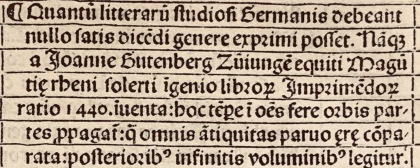
10) 319J Macer Floridus ( ascribed to) Odo of Meudon, Otto of Morimont )
Macri philosophi De uirtutibus herbarum et qualitatibus speciebus nouiter inuentus ac impressus.
Venetiis : Venetu[m] de Vitalibus.,1508. $6,000
Quarto full early vellum with guide letters, painted initials, antique hand glosses and some underlining, at the end of the volume a manuscript index of the plants described in the text. Some wormholes that in some cases affects the print in only a minor way. “The author of these Latin verses which describe the virtue of 80 herbs, took the name Floridus, not to be confused with Aemilius Macer” [L•S•O]
Proctor-Isaac; 12750; NLM: WZ 240: BM/STC Italian, p. 401; Brunet III, 1270; Hunt 22: Pritzel (2nd ed.); 571 The Medieval Herbal
11) 313J (pseudo Gregory I, Pope, approximately 540-604).
Expositio Beati Gregorij Pape super Cantica canticorum :cantica Gregori[i] sermone breui manifestat, dulcius vt castis auribus illa sonent.
Paris: Bertholdi Rembolt et Ioha[n]nis VVaterloes, 1508. $3,800
Octavo. Full vellum. The “expositio super Cantica Canticorum” is certainly a spurious work. A distinctive early-medieval reading of the Song of Songs would grow out of this Gregorian conception of pastoral care, encouraged by the lack of one complete, authoritative patristic commentary on the Song of Songs and the concerns of the exegetes themselves.
Adams; G-1181; Moreau,; I, p. 320, 84; Rosenthal, B.M. Printed books with manuscript annotations,; 59
12) The first medieval theologian to develop a systematic treatise on free will, the virtues, and the natural law.
245J Guillermus Altissodorensis, or William of Auxerre,
Summa aurea in quattuor libros sententiarum : a subtilissimo doctore Magistro Guillermo altissiodore[n]si edita. quam nuper amendis q[uam]plurimis doctissimus sacre theologie professor magister Guillermus de quercu diligenti admodum castigatione emendauit ac tabulam huic pernecessariam edidit.
Parisiis: Pigoucheti 3 Apr. 1500. $27,000
Folio, First edition. Large woodcut device on title, bound in a beautiful Contemporary Flemish blind stamped calf over wooden boards,
Goff G718; BMC VIII, 122 ; GW 11861; Proctor 8206 ; Polain 1787 ; Bod-inc G-295; Sheppard 6326; Pr 8206;
Us copies: Astrik L. Gabriel, Notre Dame IN, Boston Public, Bryn Mawr, Columbia, Huntington, Univ.of Chicago, Univ. of Wisconsin
13) 317J Guilelmus Parisiensis.
Postilla Guillermi in Euangelia et Epistolas de tempore de sanctis et pro de functis [sic] p[er] cursum anni : vnacu[m] biblie [et] marginalib[us] apositis co[n]cordantijs castigatissimo studio emendate.
NL/NP (Straßburg: Wilhelm Schaffner 1504/07. ?) $7,900 (“Mora” dated 1497 on leaf lxxxixb.)
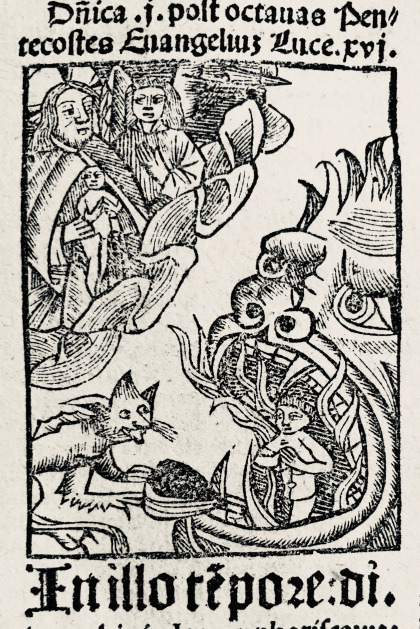
Quarto Two works bound as one in a newer vellum binding. “More than one hundred editions of the Postilla super epistolas et evangelia by Guillermus Parisiensis were printed during the fifteenth century. Surely this esteemed compilation must be regarded as one of the earliest ‘best sellers’, for how else can one explain why the text was not only frequently reprinted but was reissued time and time again by the same printer” F.W. Goff
GW dates about 1504-07 from the types.
BMC(Ger) dated about 1510.
Goff G 670; ca 1500
Assigned to Basel in Goff (“The Postilla of Guillermus Parisiensis,” Gutenberg-Jahrbuch 1959, p. 73) [Goff (P)#35.: ISTC ig00670000. Listing Bryn Mawr & Library Co of Philadelphia ; HC 8241*; VD16 E4379; Schr 4166;; IGI III p. 73; Sajó-Soltész p. 485; Voull(Bonn) 504; Pad-Ink 314; Kind(Göttingen) 2206a; BMC(Ger) p.117; BSB-Ink H-186; GW X Sp.504f. H 8241;. BSB-Ink H-186. Pell 5647. Schreiber 4166. BOD-Ink H-186.
14) 172J Heures [Vellum Printed Book of Hours (Use of Rome) In Latin and French]
Ces presentes heures a lusaige de Ro[m]me ont este faictes pour Simon Vostre Libraire domourant a Paris a la rue neuue nostre dame a le enseigne sainct Jehan l’evangeliste.
Paris [Philippe Pigouchet per] Simon Vostre, 16 Sept 1500. $21,000
Quarto full 18th century chagrin. Printed on Vellum wide margins Capitals supplied in Gold, Red and Blue
The “Sensuiuent les sept pseaulmes en françoys lacking (the second A 1-8 lacking “not surprisingly other copies are lacking the final ‘A’ quire). The present Horæ is illustrated with 22 full-page engravings in the text and numerous and smaller cuts, metal cut historiated and ornamental borders on every page, many with criblé grounds, depicting biblical scenes, the Virtues, the stag hunt, apple harvest and memento mori vignettes depicting including Pigouchet’s Dance of Death series (Claudin II, 53-53)
Goff H412; C 3106; Bohatta, H. Livres d’Heures;(1924) 730 = 705; Lacombe 109; Pell Ms 5892 (5878); Castan(Besançon) 554; Adams H1007; GW 13263. Listed copies: Cambridge UL, Oxford Bodley, Quebec Laval UL (vell), Besançon BM, Paris BN
NO copies in the US
15) 300J Johannes Sacro Bosco.
Figura sphere cu[m] glosis Georgii de Mo[n]teferrato artiu[m] [et] medici[n]e doctoris : gradiam [et] gloriam dabit dominus.
Venice [Jacobus Pentius, de Leuco] for Georgius de Monteferrato 1500, die 28 ianuarii. $11,000
Quarto, Later vellum. This is an illustrated incunable printed by Jacobus Pentius, de Leuce who started printing in 1495, his press was chiefly active after the turn of the century.
Goff J421; Klebs, A.C. Incunabula scientifica et medica,; entry 874.30; BMC V 566; HCR 14126; Essling 264; Sander 6668; Pell Ms 6718 (6683); Hillard 1153; Péligry 480; IGI 5353; Hubay(Augsburg) 1247; Pr 5705; GW M14661
16) 310. J Johannes de Sacro Bosco & ed. Francesco Capuano Di Manfredonia .
Sphera mundi nouit[er] recognita : cu[m] co[m]me[n]tarijs [et] authorib[us] in hoc volumine co[n]te[n]tis vz Capuano, Giovanni Battista Cichi Eschulani cum textu. Ioannis Baptiste Capuani. Jacobi Fabri Stapulensis. Theodosii de spheris cum textu. Michaelis Scoti questiones. Petri de Aliaco cardinalis q[uaesti]ones. Roberti Linconiensis Compendium. Theodosij iterum de spheris cum textu. Tractatus de sphera solida. Theorice planetarum conclusiones cum expositione. Campani Tractatus de sphera. Eiusdem tractatus de computo maiori. Joannis de monte regio in cremone[n]sem disputatio. Theorice textus cu[m] Joa[n]nis Baptiste Capuani exp[ositi]one. Ptolomeus De speculis. Theorica planetarum Joannis Cremonensis, plurimum faciens ad disputationem ioannis de monte regio, qua[m] in aliis hactenus i[m]pressis non reperies.
Venetijs: Luce antonij de giu[n]ta …,1518. $7,000
Folio. Original vellum. Resonances between Capuano’s commentary and Copernicus’s DE revolutionibus, I, 5-11, suggest the hypothesis that Copernicus is answering Capuano, whose work was owned by Joachim Rheticus, if not Copernicus himself.”1 The authors who Capuano choses gives us a good picture of the state of teaching Astronom in the late 15th century.” Shank (2009)
Houzeau / Lancaster I, 1642. EDIT 16 CNCE 29259. STC 597. Essling 1975. – Not in Adams.
17) 314-J. Leo I Magnus. Pope & Jacobus Lefèvre d’Étaples.
Leonis pape: hoc est pontificis maximi & sanctissimi Epistolae catholicae & sanctae eruditio[n]is plenissim[a]e
[Paris] :Iodoco Badio Ascensio. 1511. $3,400
Folio (Missing fol. CII [N3]) Bound in modern vellum.
Pope Leo I focused his pontificate on four main areas. He continuously worked to oppose and root out numerous heresies which were threatening the Western Church. Among them were Pelagianism, which involved denying Original Sin and failing to understand the necessity of God’s grace for salvation. This Roman aristocrat was the 1st pope who was given the epithet “the Great” and besides Gregorius I (540-604), the most important pope of Christian antiquity.
BM STC French,; 1470-1600, S. 262; Moreau II,; 146; Renouard, Imprimeurs & libraires parisiens du XVIe siècle,; Bade-168
18) 957G Richard Mediavilla [Middleton], d. 1302/3
Commentum super quartem Sententarium.
Venice: Christophorus Arnoldus, [circa 1476-7] $22,000
Folio {320 leaves complete} Second edition. This copy is rubricated throughout with nicely complicated red initials. Bound in modern calf over wooden boards.
Goff M-424; BMC V 206; HCR 10985; BSB-Ink R-169.050; GW M22505 :
ISTC im00422800 shows two US copies: St Louis Univ., Pius XII Memorial Library (-) & YUL – i.e. both defective. UCLA, Has a complete copy listed in their catalogue.
19) 303J Nicolaus de Orbellis
Eximii doctoris magistri Nicolai de Orbellis sup[er] se[n]te[n]tias co[m]pe[n]diu[m] Se[n]te[n]tias Compendiu[m] p[er]utile :elega[n]tiora doctoris subtilis dicta summatim co[m]plectens quod dudu[m] multis viciatu erroribus: castigatissime fuit recognitu: ac noue impressioni in: elegantiora doctoris subtilis dicta summatim complectens: quod dudu[m] multis viciatum erroribus: castigatissime fuit recognitu[m]: ac nove impressioni in Parisii commendatum.
Paris In vniuersitate parisia : Impressioni datus, studio et opera Johanis Barbier impressoris, expe[n]sis vero Johannis Petit, undated ca 1500. $3,500
Octavo .Original blind stamped calf -rebacked. Lacking final leaf. This is a commentary on John Duns Scotus’ commentary on Peter Lombard’s ‘Sententiæ’. Adams, O251;
20) 316J Nicolaus de Orbellis.
Eximii Doctoris Magistri Nicolai de Orbellis super Sententias compendiu[m] p[er]utile : elega[n]tiora doctoris subtilis dicta summatim co[m]plectens, quod dudu[m] multis viciatu[m] erroribus : castigatissime fuit recognitu[m], ac noue impressioni in Hagenarv co[m]mendatum.
(Hagenaw, impressum opera industrij Henrici Gran expensis Iohannis Rynman de Oringaw, 1503). $1,100
Quarto Lacks 11 leaves. Nicolas de Orbellis’ commentary on John Duns Scotus’ commentary on Peter Lombard’s Sententiae./ Imprint from colophon./. Bound in flexible contemporary parchment.
Adams; O249; Panzer VII, 68, 15; VD16- J 549 ; Adams O-249, CGBNP 127-561, NO 0110834, VD16 J-549; Benzing, J. Bib. Haguenovienne,; p. 11, no. 25
21) 277J Paulus Orosius
Historiae adversus paganos, edited by Aeneas Vulpes.
[Vicenza]: Hermannus Liechtenstein, [c.1475]. $ 15,000
No signatures: 100 leaves unnumbered.
In this copy there is a large opening initial in green, red, blue, and yellow, with floral extensions in the margin, other initials in red, some in blue, initial spaces, most with guide letters, rubricated. Full modern vellum. The Second edition of Orosius’s universal history, written to counter the prevailing belief among non-Christians that disasters which had befallen civilisation were the result of the pagan gods, angry with worshippers turning to Christianity.
Goff O-97; H *12099; GW M28420; BMC VII 1035; Bod-inc O-027; BSB-Ink O-82; ISTC io00097000; Goff O-97
22). 305J Pelbartus de Themeswar
Sermones Pomerii fratris Pelbarti de Themeswar diui ordinis sancti Francisci de Sanctis: Jncipiunt feliciter.
Hagenau : Heinrich Gran, for Johannes Rynman, 30 September, 1501.
[imp[re]ssi … p[er] industriu[m] Henricu[m] Gran i[n] imp[eri]ali oppido Hagenaw: expe[n]sis ac su[m]ptib[us] p[ro]uidi Joha[n]nis Rynman Finiu[n]t feliciter: Anno …millesimoq[ui]nge[n]tesimoprimo. vltimo die Septe[m]bris] $22,000
Folio Original binding calf over wooden boards. (Extensive provenience is available) As early as the 15th century, Haguenau became the second home, after Strasbourg, to distribute the printing press in Alsace. It was introduced in 1489 by Henri Gran.
Not in Goff, ISTC No.ip00252500; Hain 12557*; VD16 P1165; NO copies in the US
23) 238J Peregrinus of Opole ,) Jacobus de Voragine , Nicolaus de Dinkelsbuel Peregrinus: Sermones de tempore et de sanctis. Add: Jacobus de Voragine: Quadragesimale. Nicolaus de Dinkelsbuel: Concordantia in passionem dominicam
Est autem huius operis ordo talis. Primo ponuntur sermones d[omi]nicales de tempore per anni circulu[m]. Secundo de sanctis, Tercio q[ua]dragesimale Jacobi de Foragine, Q[ua]rto concordantia quatuor euangelista[rum] in passiiones d[omi]nicam a magistro Nicolao Dinckelspubell collectam.” At end of leaf m8: “Sermones Peregrini de tempore finiunt.
[Ulm: Johann Zainer, not after 1479] (A copy now in Munich BSB has an ownership inscription dated 1479) $14,000
Folio Original calf over wooden boards.
Only two North American copies, both defective.
Harvard University (- ff 189-278) Bryn Mawr College, (ff 239-278)
Goff P267; HC 12581*; C 4407; IGI 7404; IBP 4241; Madsen 3083; Voull(B) 2629,5; Hubay(Augsburg) 1582; Hubay(Eichstätt) 794; Borm 2059; Walsh 909; Rhodes(Oxford Colleges) 1340; BMC II 529; BSB-Ink P-183; GW M30917 – Wegener, Zainer 9 – BSB-Ink P-183 – Proctor 2542 ISTC ip00267000
24) 145J Paulus Pergulensis
Logica magistri Pauli Pergulensis.
Venice: Johannes Emericus, de Spira, 1495/96. $12,500
Quarto. 10 x 8 ½ inches. a-e8, f44 of 44 leaves (complete)
Signature of Thomas Stewart, Knight of St. John of Jerusalem, dated Rome 1837 on title. Bound in early 19th-century quarter sheep; light damp staining in lower margins throughout, title and last page soiled.
Goff P195; H 12626; R 1314; Sander 5476; IBE 4363; IGI 7322; IBPort 1357; Horch(Rio) Suppl 13; Mendes 957; GW M30234US Copies (Princeton Univ (2) and The Newberry Library) Not in Copinger or British museum Catalogue of books printed in the XVth century.
25) 318J
Stella clericorum cuilibet clerico summe necessaria
[Leipzig] : [Conrad Kachelofen], before 1492. $4500
Quarto Bound in modern boards. Initals supplied in read and internal capitals stroked. This copy is lacking the final leaf comprising the poem” Aspice presentis”

“One of the forgotten works of the Middle Ages is the Stella clericorum, Though short, often derivative in content, and generally rather unassuming, the Stella clericorum was nonetheless one of the most popular traetises of the later Middle Ages. Stella clericorum communicates, in simplistic form and for the use of lower clergy, many of the grand ecclesiological and ritual accom- plishments of the twelfth century. Its principal themes are the dignity of the priesthood and the importance of the Eucharist.”. (CAROL NEEL, Colorado College 1997)
Goff S 775. ISTC is00774800/ (listing Huntington & Newberry only )IBP 5110. H 15065; BSB-Ink S-578; IG 2522;H 15065*; IBP 5109; Sajó-Soltész 3142; Coll(S) 999; Voull(Bonn) 1091; Günt(L) 1348; Hubay(Würzburg) 1954; Ohly-Sack 2590; Borm 2522; [The copy in München BSB has an owner’s inscription with the date 1492]
26) 35J Nicolaus Tygrinus or Tegrinus or Tegrini
Lucensium Oratio Luculentissima Pont. Maximo Alexandro Sexto per Nicolaum Tygrinu[m] Lucensem Vtriusq[ue] Iuris.
[Rome], [Andreas Freitag ],15 October 1492 $5,900
Quarto, First edition, Modern roan boards. Oration such as this are usually rare and short this one is both it is a tribute from the City of Lucca to the election of Pope Alexander VI.
CF Bühler, The Earliest Editions of the “”Oratio”” (1492) by Nicolaus Tygrinus (in: Gutenberg JB 1975, pp. 97-99)” Goff T563; HC 15751*; Pell Ms 10972; CIBN T-51; Nice 209; IGI 9670; IBE 5542; BMC IV 137;
27) 246J Gerardus de Zutphania
[ De spiritualibus ascensionibus.]
Tractatus de spiritualibus ascensionibus Add: David de Augusta: De exterioris et interioris hominis compositione Lib. II, 1 (De quatuor in quibus incipientes deo servire debent esse cauti)
[Basel : Amerbach and Petri de Langendorff, not after 1489]. $6,000
Octavo 67 of 68 leaves. Lacking a1 title. Rubricated in red, initials painted in red, blue and green. Contemporary binding in full calf, with blind tooling, spine slightly rubbed Final leaf blank. “the most fertile and the most successful writer the Brothers [of the Common Life] ever produced.” “Zerbolt outlines how one can redeem the soul from its fallen state, moving to higher and higher levels through “self -knowledge, repentance, combat of sin, mortification, the practice of humility and obedience.”
(Post “The Modern Devotion”)
Goff,; G177;ISTC,; ig00177000; Oates,; 2803; Bod-inc,; G-081; Pr,; 7638; BMC,; III:752; BSB-Ink,; G-127; GW,; 10689
James Gray Booksellers LLC C. 617-678-4515
[email protected] No.1
My first ‘Short title catalogue’ (No1) The reason for publishing a short catalogue is to facilitate easier and cheaper shipping so that I can ship anyone who asks for one will get one quickly.
0 notes
Text
‘In the reference room’: a visit to the Mitchell Library’s Special Collections and Archives.

Helen Vincent, Head of Rare Books, Maps and Music at the NLS, Edinburgh
In the spirit of Tillie Olsen, and her lifetime’s project of finding silenced writers and asking us to listen to them, the Hitherto Unknownresearch group met on Thursday 1stNovember 2018 from 5:30-7:30pm at the Archives and Special Collections Department on the 5thfloor of the Mitchell Library in Glasgow. The aim of the meeting was to find out more about how to access the vast swathes of material both catalogued and uncatalogued, digitized and analogue, available at the Mitchell library and the NLS in Edinburgh.
We were inspired by Tillie Olsen’s own account of one her famous works of recovery:
“It was not until the collected Letters of Emily Dickensoncame out in 1958 that, in the reference room of the San Francisco Public Library where I went luch hours from work to read them, I learned who the author [of Life in the Iron Mills] was. Appended to a note from Emily to her sister-in-law,
Will Susan please lend Emily “Life in the Iron Mills”—and accept blossom
was this citation:
Rebecca Harding Davis’ “life in the Iron Mills” appeared in the April 1861 issue of theAtlanti Monthly.
Olsen, T (2003), Silences, p117
As a result of Olsen’s finding these bibliographic details of a text she’d read twenty one years previously in “one of three water-stained, coverless, bound volumes of the Atlantic Monthly, bought for ten cents each in an Omaha junkshop,”[1]when she was just fifteen years old, she was able, many years later, to teach the text on her Amherst courses, eventually publishing the Reading Lists she devised there in the Feminist Press’ Women’s Studies Newlsetter[2]. In 1970, she approached Florence Howe, founder of the Feminist Press, who recalls that Olsen “gave Life in the Iron Millsto the Feminist Press and said she had written a biographical and literary afterword that we could have as well, that changed the whole course of publishing for the press”[3]. As a result, Rebecca Harding Davis’s incredible story of a working-class artist and iron worker, originally written in 1861, was reprinted by the press in 1972, and remains in print to this day, recognised as one of the earliest examples of American Realism.

Isobel Maclellan (centre), librarian at the Mitchell Library’s Special Collections & Archives department
The first speaker at the Hitherto Unknown event was Isobel Maclellan, a librarian at the Mitchell’s Archives and Special Collections Department. Firstly, Isobel was keen to emphasise that anyone can access the archives at the Mitchell—you don’t have to be a student or have a letter of recommendation or anything like that. Special Collections includes local history in books, photographs and ephemera as well as family history and newspapers. It also holds a range or rare books and manuscripts, including books printed before 1500 (Incunabula) and broadsides (large sheets of paper printed on one side only).
One thing Isobel wanted to make clear was that many of the materials held in the library are not listed on the online catalogue, which only deals with acquisitions from 1970 onwards—and many items are not catalogued full-stop. This means that the potential for making an exciting find is enormous. Staff are happy to help with any searches you’d like to make and can show you how to search using card indexes, finders or microfiche catalogues. Isobel also showed us the request slips you can fill in if you’re looking for specific material. Staff will do their best to find what you are looking for, and are often the key to finding your way around material that hasn’t yet been catalogued. There is an oversized folder on the desk in the Glasgow Room on level 5 which lists many periodicals and journals held in the collection, including the the Glasgow socialist newspaper Forward, one of which Isobel had brought along with her to show us.
It was a gigantic newspaper, rich with illustrations and articles that couldn’t be found anywhere else in Scotland. Isobel also showed us one of Janice Galloway’s notebooks from when she was writing The Trick is to Keep Breathing, and some of her unpublished short stories. There were also some original letters from Catherine Carswell to F. Marion McNeill. It’s incredible that all you have to do to sit with these items and leaf through them is go in and ask! If you want to look at the items, you have to do so in the Special Collections department and Reading Room on the 5thFloor. Anyone can go in as long as they leave their coats, bags and pens in the lockers provided—pencils only!
After Isobel’s talk, Helen Vincent, Head of Rare Books, Maps and Music Collections (dream job title!) at the NLS spoke about how to look for books written by women using a catalogue system that doesn't mark the gender of authors. Searching political documents won’t get you very far, she said, as women were excluded from that realm for many years. However, women were ‘allowed’ a voice in religious matters and so it can help to start your search for texts by women there. She also told us about some of the out-of-copyright Scottish books that have recently been digitised, including literature by Violet Jacob and Catherine Carswell, and talked about Henrietta Liston's journals, as well as NLS online resources such as 'A guid cause', a toolbox about the women’s suffrage movement in Scotland made using archival sources from the NLS’s collections.
The group then spent some time looking through the archival materials on display, and fed back to the group about any 'finds'. One participant talked about community newspaper collections from the 1970s from Castlemilk and Govanhill; another read a verse from a poem by Nat Raha, a contemporary poet who lives in Edinburgh. Another participant talked about Agnes Owens, a Scottish novelist and short story writer, whilst someone read from the Janice Galloway collection, having enjoyed reading one of her short stories. We briefly talked about moving forward, about starting to use the archives at the GWL, the NLS, the Mitchell and beyond to inform our own research as we begin making our own reading lists in the spirit of Tillie Olsen, and for our own time and place.

France Corr reads one of her poems
Frances Corr finished the session by reading two poems to the group. Both resonated strongly with us and were situated in the domestic, another space that is often uncatalogued and silenced, or unheard. We hope to explore the domestic next year when we visit the NLS Moving Image Archive on Saturday 9thMarch 2019and take a look at some of their home movies with Emily Munro, the Learning and Outreach worker there. Joey Simons of Hitherto Unknownfirst heard Frances’ work at a Women Against Capitalism event in Castlemilk. We hope to draw together the work of more writer/activists, those writing prose or poetry that is against. Finally, at a research workshop at Platform in Easterhouse on Monday 4thFebruary 2019, web archivists from the NLS will help us learn how to archive work published on the internet, whether as video, image or text.
In the afterword to the anthology of afro-American writing,Black Fire, Larry Neal wrote: “The artist and the political activist are one. They are both shapers of the future reality”[4]. And yet, as in the case of Davis’s Life in the Iron Mills,the brilliance of a text is not enough to preserve it in a world where those who can shout the loudest are often those with the means and power to widely broadcast their ideas and culture. It is our task to keep reading, keep sharing, keep enthusing and documenting, taking these texts into an ever-shifting working-class culture of our own, that aims to disrupt the one that is daily shoved down our throats. We hope you can join us!
[1]Olsen, T. (2003), Silences, New York: The Feminist Press, p117.
[2]ibid. p298.
[3]Howe,F. (1994), quoted in Listening to Silences: New Essay in Feminist Criticism,Hedges,E and Fishkin, S.(eds.), New York: Oxford University Press, P27
[4]Jones,L & Neal, L (ed.) Black Fire: An Anthology of Afro-American Writing,New York: William Morrow & Company, Inc, P656.
0 notes
Text
305J Pelbartus de Themeswar (1430-1504)
305J colophon
Sermones Pomerii fratris Pelbarti de Themeswar diui ordinis sancti Francisci de Sanctis: Jncipiunt feliciter.
Hagenau(Augsburg): Heinrich Gran, for Johannes Rynman, 30 September, 1501. [imp[re]ssi … p[er] industriu[m] Henricu[m] Gran i[n] imp[eri]ali oppido Hagenaw: expe[n]sis ac su[m]ptib[us] p[ro]uidi Joha[n]nis Rynman Finiu[n]t feliciter: Anno … millesimoq[ui]nge[n]tesimoprimo. vltimo die Septe[m]bris] $16,000
Folio 12 x 8 inches Probably about the fourth edition. ( the listings for this book are all pretty sloppy despite Gran’s placing the exact dates in the colophon:20 feb 1499, 10 November 1499, 8 June 1500,
COLLATION:Completely unpaginated throughout, Signatures: pi6 [chi]6 a-b8 c6 d-e8 f6 g-h8 i6 k-l8 m6 n-o8 p6 q-s8 t6 v-x8 y6 z8 A8 B6 C-D8 E6 F-G8H6 I-K8 L6 M-N8 O6 P-Q8 R6 S-T8 U6 X-Y8 Z6 [&]8 leaves 12 and 358 blank . ( 13, 357 ff. ) TYPE: two columns, 58 lines per page plus headline, gothic letter, with guide letters and spaces for numerous four and six line ornamental capitals, contemporaneously hand rubricated in red ink throughout.
This copy is bound contemporary blind-stamped leather over wooden boards from an Augsburg workshop operating between 1482 and 1532 (Kyriss 79). Front board panelled with two blind rolls, one formed of arches, the other of birds and flowers, panel filled with further use of bird and flower blind roll and surmounted by blind-lettered title “POMERIUS*S”. Rear board panelled with same bird and flower blind roll, panel infilled with diagonally crossing blind fillets. There is Early monastic ink title to fore-edge and ink inscription to front free endpaper, nineteenth century ink inscription to front pastedown, wormholes to opening and closing leaves, a couple of unobtrusive wormholes extending into first few quires touching a few letters, corners of two leaves torn well clear of text, leaf A8 soiled at edges and possibly supplied from another copy, occasional very light paper browning otherwise internally clean. Binding worn with minor chips and losses, spine with minor loss especially at head, paper monastic library label to foot of spine, upper edge of rear board damaged exposing wood beneath (not affecting blind rolls), remains of hasps and clasps, light marks to centre of each board where central brass bosses were once affixed.
The Bavarian binding and inscription to its front free endpaper indicate very early acquisition by the medieval Benedictine Monastery of the Abbey of Irsee, Bavaria. Upon the dissolution of Bavarian monasteries in 1803 the volume was acquired by Munich Court Library; a nineteenth century ink inscription to the front pastedown notes the copy to have been a duplicate and it was doubtless sold between 1815 and 1859 when the library instigated a series of large auctions to dispose of surplus items. Sometime after 1880 it was acquired by the Benedictine monastery of Erdington Abbey, Birmingham, England, established for monks expelled in Bismarck’s kultur-kampf from Beuron, Prussia. In 1922 the Erdington monastery was dissolved following return of its monks to Beuron after World War I, and its library appears to have been subsequently disbursed. BIBLIOGRAPHICAL REFERENCES: Included in the Incunabula Short Title Catalogue, ISTC ip00252500, citing holdings at 15 locations globally with none in the US or UK; Hain 12557 (describing an imperfect copy). An attractive copy of this rare early work in entirely original state with substantial provenance.
Fourth or so edition of this collection of sermons by Pelbartus de Themesvar, Hungarian Franciscan at the St.John Monastery in Buda. The popular text was first published in 1499 He was born in 1430 in Temesvár, Hungary (now Timişoara, Romania). In 1458 he went to the University of Kraków. In 1463 he was licensed in Theology. Possibly in 1471 he left Kraków as a doctor, then in 1483 he is mentioned in the Franciscan Community Annales of St. John Monastery in Buda, the Hungarian Capital city. After 1483 his writings began to be published in print. The first printed edition of his Sermons dates from 1498. In 1503 a printed version of his lecture notes was published. Pelbartus died on 9 January 1504 in Buda, as a highly distinguished author and professor. Hungarian versions of his writings in manuscript date from 1510.
ISTC No.ip00252500; Hain 12557*; VD16 P1165; Sajó-Soltész p. 767; Günt(L) p.65; Wilhelmi 479a; GW M30525
Holdings
AustriaGraz, FranziskanerZB (imperfect)
Scheibbs, Kapuziner
Schwaz, Franziskaner (Ink U1/1-02) EstoniaTallinn Arch GermanyBerlin, Staatsbibliothek (3)
Gotha ForschLB
Greifswald GeistlMin
Leipzig UB
Mainz GM/StB (2, Ink.1107,2553)
München, Bayerische Staatsbibliothek
München MetropolitanKap (I117/1a)
München UB
Rostock UB
Wolfenbüttel, Herzog August Bibliothek HungaryBudapest Bibl nat
Number of holding institutions15
Last Edit2016-07-13 12:00:00.00
No US Copy (not in Goff) No UK Copy 305J Pelbartus de Themeswar (1430-1504) Sermones Pomerii fratris Pelbarti de Themeswar diui ordinis sancti Francisci de Sanctis: Jncipiunt feliciter.
0 notes